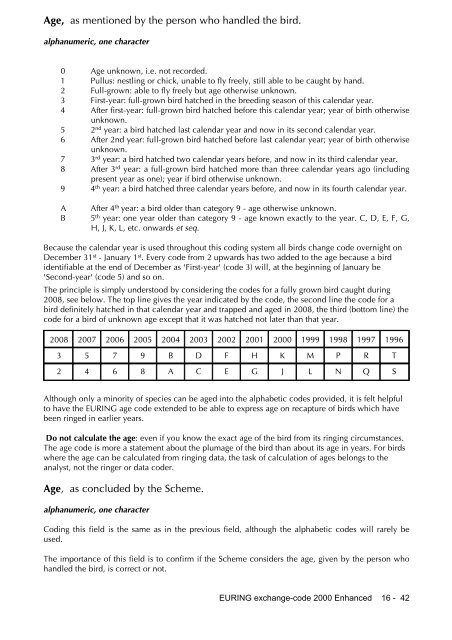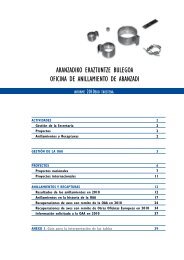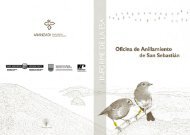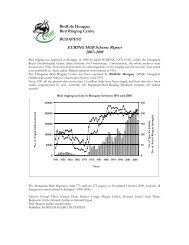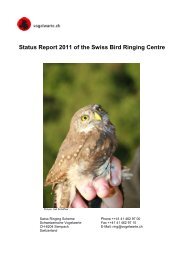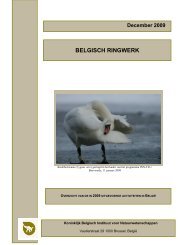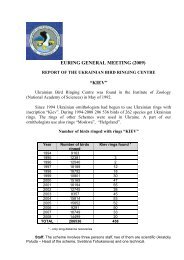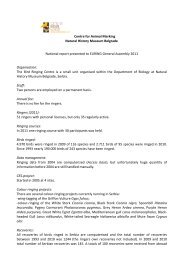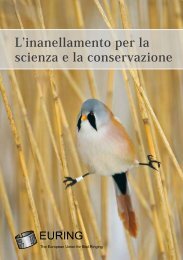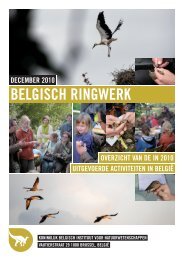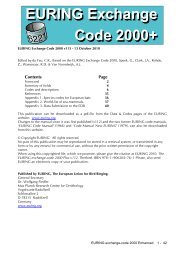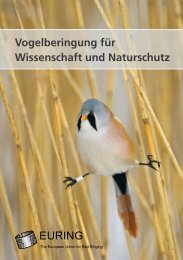here - The European Union for Bird Ringing
here - The European Union for Bird Ringing
here - The European Union for Bird Ringing
You also want an ePaper? Increase the reach of your titles
YUMPU automatically turns print PDFs into web optimized ePapers that Google loves.
Age, as mentioned by the person who handled the bird.<br />
alphanumeric, one character<br />
0 Age unknown, i.e. not recorded.<br />
1 Pullus: nestling or chick, unable to fly freely, still able to be caught by hand.<br />
2 Full-grown: able to fly freely but age otherwise unknown.<br />
3 First-year: full-grown bird hatched in the breeding season of this calendar year.<br />
4 After first-year: full-grown bird hatched be<strong>for</strong>e this calendar year; year of birth otherwise<br />
unknown.<br />
5 2 nd year: a bird hatched last calendar year and now in its second calendar year.<br />
6 After 2nd year: full-grown bird hatched be<strong>for</strong>e last calendar year; year of birth otherwise<br />
unknown.<br />
7 3 rd year: a bird hatched two calendar years be<strong>for</strong>e, and now in its third calendar year.<br />
8 After 3 rd year: a full-grown bird hatched more than three calendar years ago (including<br />
present year as one); year if bird otherwise unknown.<br />
9 4 th year: a bird hatched three calendar years be<strong>for</strong>e, and now in its fourth calendar year.<br />
A After 4 th year: a bird older than category 9 - age otherwise unknown.<br />
B 5 th year: one year older than category 9 - age known exactly to the year. C, D, E, F, G,<br />
H, J, K, L, etc. onwards et seq.<br />
Because the calendar year is used throughout this coding system all birds change code overnight on<br />
December 31 st - January 1 st . Every code from 2 upwards has two added to the age because a bird<br />
identifiable at the end of December as 'First-year' (code 3) will, at the beginning of January be<br />
'Second-year' (code 5) and so on.<br />
<strong>The</strong> principle is simply understood by considering the codes <strong>for</strong> a fully grown bird caught during<br />
2008, see below. <strong>The</strong> top line gives the year indicated by the code, the second line the code <strong>for</strong> a<br />
bird definitely hatched in that calendar year and trapped and aged in 2008, the third (bottom line) the<br />
code <strong>for</strong> a bird of unknown age except that it was hatched not later than that year.<br />
2008 2007 2006 2005 2004 2003 2002 2001 2000 1999 1998 1997 1996<br />
3 5 7 9 B D F H K M P R T<br />
2 4 6 8 A C E G J L N Q S<br />
Although only a minority of species can be aged into the alphabetic codes provided, it is felt helpful<br />
to have the EURING age code extended to be able to express age on recapture of birds which have<br />
been ringed in earlier years.<br />
Do not calculate the age: even if you know the exact age of the bird from its ringing circumstances.<br />
<strong>The</strong> age code is more a statement about the plumage of the bird than about its age in years. For birds<br />
w<strong>here</strong> the age can be calculated from ringing data, the task of calculation of ages belongs to the<br />
analyst, not the ringer or data coder.<br />
Age, as concluded by the Scheme.<br />
alphanumeric, one character<br />
Coding this field is the same as in the previous field, although the alphabetic codes will rarely be<br />
used.<br />
<strong>The</strong> importance of this field is to confirm if the Scheme considers the age, given by the person who<br />
handled the bird, is correct or not.<br />
EURING exchange-code 2000 Enhanced 16 - 42


